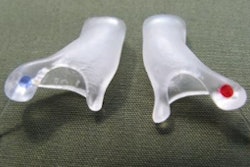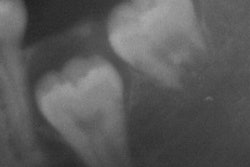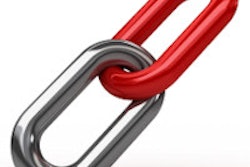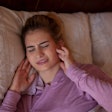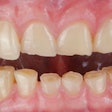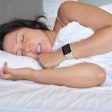
Temporomandibular joint disorder (TMD) and general jaw pain, fatigue, and soreness can stall dental procedures, and the Restful Jaw Company has created a device in response.
The Restful Jaw device is designed to aid and increase the efficiency of TMD treatment and also serves to enable the uninterrupted treatment of other indications. The external jaw support device can be placed on most adult-size patients, and supports the patient's jaw in the open mouth position with a memory foam cushion. The company is currently developing an extension for pediatric patients.
 The Restful Jaw device fits over the patient's shoulders. Image courtesy of the Restful Jaw Company.
The Restful Jaw device fits over the patient's shoulders. Image courtesy of the Restful Jaw Company.The Restful Jaw can be employed for long procedures that require patients to hold their mouth open for an extended duration or for patients sensitive to jaw pain and fatigue, such as those with TMD.
Registered with the U.S. Food and Drug Administration, the device has been clinically shown to help support a patient's jaw while minimizing jaw pain, fatigue, and soreness during dental procedures. Introduced at the Minnesota Dental Association's 2012 Star of the North Meeting, the device was invented by Eric Schiffman DDS, an associate professor and director of the division of TMD and orofacial pain at the University of Minnesota School of Dentistry. He designed and has tested the device with an $8.2 million National Institutes of Health grant.
"In my decades of treating TMD, patients have told me how they dread their regular dental appointments," Dr. Schiffman stated in a press release. "They'll avoid any extra treatment possible to minimize their jaw pain. Dentists have told me how time-consuming and difficult it is to treat patients who experience jaw symptoms during and after dental treatments." That led to the idea he had for the device.
Patients do not have to tense their jaw muscles to hold their mouth open or resist the downward forces applied during treatment when wearing the device. It was strategically designed to avoid interference with dental work and will not block access to the patient's airway. Consequently, patients and dentists can experience shorter treatment times when patients do not need to take breaks or terminate procedures because of pain.
“TMD patients have told me how they dread their regular dental appointments.”
Fitting a patient takes approximately three minutes. The structure of the device improves jaw stability and prevents jaw locking and overextension, while reducing medicolegal risks by supporting and protecting the patient's jaw, according to the company.
In the U.S., 31 million adults experience jaw pain and discomfort from routine dental care, and more than 5 million patients terminate dental care due to unbearable jaw pain, the company noted. The device was invented in response and to help prevent dental procedures from causing TMD or exacerbating patient's existing symptomatic or asymptomatic jaw conditions.
The main indications include the following:
- Any procedure that places significant force on the patient's jaw such as extractions
- Asymptomatic patients with signs of TMD
- Patients with movement disorders such as Tardive dyskinesia, Parkinson's disease, multiple sclerosis, and hyperactivity
- Endodontics, periodontics, prosthodontics, and restorative and oral surgery
- Geriatric patients
The textile parts of the device are machine-washable, and the device can be cleaned with standard medical wipes after use.




